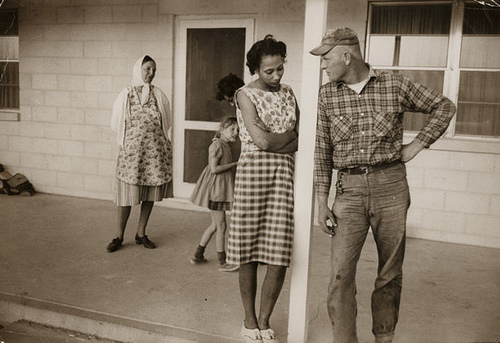A white man and an African American woman hold hands and walk slowly through the doorway, crossing its threshold to see a photography exhibit. Forty-five years ago, their relationship would have been illegal in many states. The couple is at the International Center of Photography in midtown Manhattan, and they’ve have come to see an exhibition entitled “The Loving Story: Photographs by Grey Villet.”
 In 1967, Photojournalist Grey Villet was assigned by LIFE magazine to take photos of the Loving family. Barbara Villet, the photojournalist’s widow, told the New York Times that her husband sought to capture the Lovings’ family “as real as he could get it.” His photos did not reflect the legal turmoil that was affecting the interracial family, but rather the love that was so obvious in their everyday actions.
In 1967, Photojournalist Grey Villet was assigned by LIFE magazine to take photos of the Loving family. Barbara Villet, the photojournalist’s widow, told the New York Times that her husband sought to capture the Lovings’ family “as real as he could get it.” His photos did not reflect the legal turmoil that was affecting the interracial family, but rather the love that was so obvious in their everyday actions.
The 1967 case, Loving v. Virginia, was a milestone in the fight for civil rights. In it, the Supreme Court unanimously ruled against Virginia’s anti-miscegenation laws.
When Mr. and Mrs. Loving married in 1958, Virginia was one of 24 states in which interracial marriage was illegal in the United States. Having wed legally in Washington DC, the Lovings were found to be breaking the law upon returning to their home in King and Queen County, Virginia. On July 11, 1958, just five weeks after their marriage, police burst into the Loving’s home and arrested them for violating a Virginia law known as the Racial Integrity Act. The judge who presided over their case, Leon M. Bazile, said that God would not have put different races on different continents if he intended for them to mix.
In 1963, Mrs. Mildred Loving wrote to Attorney General Robert. F. Kennedy about their situation. Kennedy referred her to the American Civil Liberties Union. Years later, in 1967, the Supreme Court agreed to take up the case.
 Mrs. Loving died in 2008, just a year after the 40th anniversary of the ruling. According to her obituary in the New York Times, Mr. Loving died in a car accident only eight years after the 1967 Supreme Court ruling. In her last issued statement during this year, Loving said that she hoped same sex couples would have the right to marry.
Mrs. Loving died in 2008, just a year after the 40th anniversary of the ruling. According to her obituary in the New York Times, Mr. Loving died in a car accident only eight years after the 1967 Supreme Court ruling. In her last issued statement during this year, Loving said that she hoped same sex couples would have the right to marry.
According to David Appel, Communications Associate at the International Center of Photography, the case continues to have relevance today as marriage equality gains support and the first mixed-race U.S. president finishes his first term.
“We also wanted to highlight a wonderful photo essay by Grey Villet, a great yet relatively unknown photojournalist,” said Appel in an email.
The photographs are not part of ICP’s collection, but are borrowed vintage prints from Richard and Mildred’s daughter Peggy Loving and the estate of Grey Villet. Appel also said that the exhibit has specific relevance to life in New York City today.
“There are many married mixed-race couples in New York City and it’s important to learn about the real people who made this possible,” he added.
The exhibition has generated particular interest among younger viewers who are surprised to learn that interracial marriage was once illegal, Appel said. “Most are touched by Villet’s powerful and intimate images of this ordinary yet extraordinary family.”
Funded by the New York City Department of Cultural Affairs in partnership with the City Council, The Loving Story will be on view at ICP through May 6, 2012.







Leave a Reply